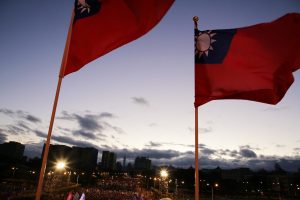Will China invade Taiwan? With Afghanistan and Syria fading from the headlines, it seems to have become the preeminent strategic question of the fall, bolstered by hawkish statements from Xi Jinping, record-setting Chinese aerial incursions into Taiwan’s air defense identification zone, and revelations that U.S. troops have been conducting training missions on Taiwanese soil.
There is little doubt that the People’s Liberation Army is conventionally superior to Taiwan’s military. It could hardly be otherwise, given the vast disparity in population size and GDP, not to mention Beijing’s pressure campaign to limit Taipei’s access to international arms markets. The open question is whether Taiwan’s forces could inflict enough harm on the People’s Liberation Army to make it politically or strategically unfeasible for an invasion to succeed.
It is an open question in part because, since their last clash in the late 1950s, the two militaries have not fought each other – indeed, neither military has much of a contemporary combat record at all to draw inferences from. But more broadly, there are relatively few examples of how modern militaries fare under sustained assault from a numerically and technologically superior opponent. The Georgian military, in 2008’s summer war with Russia, managed to inflict significant casualties and destroy some high-status hardware, but failed to stop Russia from achieving its objectives in relatively short order. (Moreover, the Russian military of 2008 was far less modernized and sophisticated than it is today, in part because the war with Georgia exposed many of its shortcomings.)
Other recent engagements give at least some hints as to what vulnerabilities may exist. Armed drones have been notably successful against conventional military targets in Nagorno-Karabakh, Libya, and Syria – though it is worth pointing out that in almost all of those instances, they were being used against targets defended by point rather than integrated air defense networks. Ballistic missiles remain capable of doing real harm to facilities and other immobile targets, even those protected by state-of-the-art defense systems. And the fact that even limited numbers of anti-ship missiles have proved capable of wreaking havoc on warships suggests that major surface combatants are at severe risk from the large missile arsenals of heavily industrialized state adversaries.
Those vulnerabilities go both ways, of course – the airfields and warships of larger powers have the same inherent vulnerabilities as those of smaller states. But where there is a major imbalance of forces – as exists across the Taiwan Strait – a smaller power’s military can give as good as it gets and still lose the war.
Strengthening conventional forces to address imbalances is the obvious solution, but it has significant limitations. Most democratic nations have moved away from conscription, and peacetime professional militaries often struggle to fill their existing ranks, let alone expand (Taiwan is no exception, as John Oliver recently observed). That problem extends beyond simply filling the ranks of infantry units; a military that can’t draw on a deep reserve of different kinds of talents will find it more difficult to maintain and effectively operate its most sophisticated and effective weapons systems. That in turn means that simply spending more money and buying state-of-the-art combat systems is not in and of itself a solution either.
This is not to suggest that conventional armaments and military formations are pointless in the face of larger adversaries. But they should not be considered as the only aspect of national defense and deterrence. Technology might have reshaped battlefield capabilities, but to conquer and hold territory still requires a large force of military personnel to undertake the tasks of occupation with a coherent and achievable political objective. That creates its own vulnerabilities, which can be exploited by a sufficiently prepared civilian population.
To be clear, this is not a suggestion to create hidden paramilitary forces ready for activation in the small democracies of the world. As NATO discovered with Operation Gladio, attempting to do so is inherently antidemocratic and creates enormous blowback, serious unintended consequences, and – given the necessary secrecy – provides very limited deterrent effect.
Rather, the purpose should be to prepare a civilian population to make themselves as inconvenient as possible to potential occupiers. This is not a novel idea; the CIA’s predecessor, the Office of Strategic Services, produced a “Simple Sabotage Field Manual” in 1944, which gave simple, easy-to-understand instructions for how ordinary workers could introduce friction and difficulty into the lives of occupying military forces. Much of the content within it is badly outdated (though office workers will perhaps recognize many of the bureaucratic tactics it suggests from their own lives). A modernized attempt to pre-organize sabotage, friction, and non-violent resistance in potentially vulnerable states could – if judiciously publicized – contribute to strategic risk calculations amongst potential aggressors. It should be noted, though, that this depends on how much economic value is part of those calculations – if the aggressor views a potential campaign of conquest through a primarily nationalistic lens, the prospect of industrial and commercial sabotage might not have much impact.
Of course, the world of 2021 is not the world of 1944. From the perspective of countries that are relatively safe from invasion but wracked with sociocultural polarization, it might seem unwise to intentionally introduce the prospect of sabotage as a deterrent. But as one mechanism amongst many, it is at least worth considering how the population of a smaller, vulnerable state can threaten to create enough friction to be worth taking seriously.

































